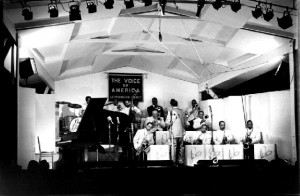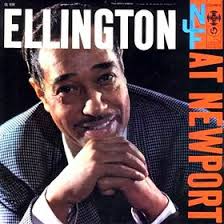BY KATHERINE WILLIAMS
Most people think of three things when they think of jazz history:
- jazz was made famous by a succession of individual musicians (Buddy Bolden, Louis Armstrong, Duke Ellington, Charlie Parker, Sonny Rollins etc.)
- jazz is predominantly an improvised music, and
- jazz is an oral tradition (rather than notated art form), and we can best gain access to those past traditions through jazz recordings.
My current research seeks to address these popular conceptions through a detailed investigation of the Duke Ellington Orchestra’s performance and recording at the Newport Jazz Festival in 1956.

There are many reasons for this case study: Duke Ellington is a key figure in jazz, having directed, composed for, and played piano with his own group from 1917 until his death in 1974. Band members (famous musicians such as alto saxophonist Johnny Hodges, baritone saxophonist Harry Carney and trumpeter Cat Anderson and others) tended to stay with the group for years if not for life, contributing to a jazz orchestral palette that became consistent and recognisable.
The jazz festival held annually in Newport, Rhode Island since 1954 was the first of its kind. It was funded by socialites Elaine and Louis Lorillard, and artistically headed by nightclub owner and record impresario George Wein.
Wein’s vision for the festival was to bring to this resort town a replication of ‘my nights in New York City when I … heard Dixieland, big bands, swing, unique singers and modern jazz.’ The Newport Jazz Festival grew annually in popularity and prestige, and quickly became a place for jazz musicians and fans to see and be seen, to hear and be heard.
Without a doubt, Duke Ellington was the driving force and figurehead behind the group. He was sophisticated, stylish and possessed the crucial flair for band management and engaging a crowd. He was the artistic and compositional mind behind the band’s repertoire, cementing him further into cultural imagination as one of the ‘great men’ of jazz.
Yet further investigation shows that his co-composer Billy Strayhorn contributed vastly to the band’s programme for the night—often sharing the compositional load with Ellington, providing his own charts, or editing numbers after their initial performance. Long term band members also contributed to Ellington’s compositional style, offering stylistic characteristics and improvised ideas that became embedded into the band’s repertoire.
The Duke Ellington Orchestra’s performance at Newport on 7 July 1956 caused a sensation. This was due in large part to a twenty-seven chorus improvised blues solo by tenor saxophonist Paul Gonsalves, which connected the sections of Diminuendo and Crescendo in Blue.
This solo drove the crowd into a frenzy, and was later recognised by producer George Avakian as ‘one of the longest and most unusual tenor sax solos ever captured on record’. Gonsalves’ improvisation supports a common understanding about jazz: that improvisation comes from the heart, that the spontaneous is of more value than the planned, and that the orally espoused and learnt is worth more than the notated, scored traditions of Western Art music.
Yet here again Ellington’s practices, and the example of Newport 1956, defy common assumptions about jazz. As Walter van de Leur writes, ‘Ellington … for the larger part of his career, relied on written scores and parts, a practice he started somewhere in the early thirties as a result of the increasing complexity of his music and the growing number of voices in his band. The hundreds of detailed scores and literally thousands of written instrumental parts in the repository of the Duke Ellington Collection’ evidence this.
Consideration of the many recordings made of Diminuendo and Crescendo in Blue with Gonsalves ‘improvising’ the central interval show that he solidified a performance routine over time.
We can speculate about why this was so—perhaps he was responded to the audience enthusiasm for his improvisatory stamina, or perhaps it was an inevitable effect of improvising in the same musical spot, with the same musicians backing him, night after night. Either way, a curious result of repeated performances is that his ‘unusual tenor sax solo’ became a predictable crowdpleaser.
The 1956 Newport performance was featured as part of Columbia Records’ new venture in long-playing live records. This helped to cement the widely accepted belief that jazz history can be constructed from the recordings available. The live recording was released later the same year to great acclaim.
In 1999, however, it became apparent that the so-called live recording was in fact ‘patched up’ in the studio, a practice suggested by Duke Ellington, aided by Billy Strayhorn, and facilitated by producer George Avakian. In fact, several numbers were re-recorded in their entirety two days after the live performance (and released as the Duke Ellington at Newport album).
Producer and DJ Phil Schaap located and remastered the original live tapes, and issued both the live and repaired recordings on Duke Ellington at Newport: Complete. (My forthcoming work on this issue includes a detailed study of Avakian’s archives, and a new interview with Phil Schaap, and part of my role as scholar is to re-create events and attitudes from often conflicting and complex accounts.)
The fact remains, however, that for more than a quarter of a century, jazz fans and scholars alike believed that the issued live recording was a documentation of how the Duke Ellington Orchestra sounded live in 1956. This example shows that a jazz history constructed from recordings deserves revisiting.

About the author:
Dr Katherine Williams is a Lecturer in Music at Plymouth University. She is the author of Rufus Wainwright (2016) and co-editor of The Cambridge Companion to the Singer-Songwriter (2016). In 2015, she was awarded the Ella Fitzgerald Charitable Foundation/Jazz Education Network Jazz Research Fellowship, which funded a visit to the Duke Ellington Collection at the Smithsonian Institute in Washington DC, and the Institute of Jazz Studies at Rutgers, New York.

